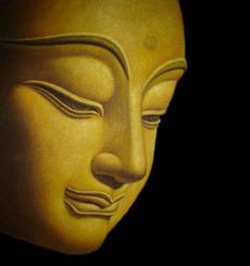Difference between revisions of "''Bestowal of Prophecy'' chapter"
| Line 1: | Line 1: | ||
[[File:87250-84352.jpg|thumb|250px|]] | [[File:87250-84352.jpg|thumb|250px|]] | ||
| + | |||
| + | |||
| + | |||
| + | |||
| + | |||
| + | |||
<poem> | <poem> | ||
| − | "[[Bestowal of Prophecy]]" chapter | + | "[[Bestowal of Prophecy]]" [[chapter]] |
[[授記品]] ( Jpn [[Juki-hon]] ) | [[授記品]] ( Jpn [[Juki-hon]] ) | ||
| − | The sixth chapter of the [[Lotus Sutra]]. The "{{Wiki|prophecy}}" in the title means that made by [[Shakyamuni Buddha]] as to when, where, and under what names his [[disciples]] will become [[Buddhas]]. In this chapter, [[Shakyamuni]] prophesies that the four great [[voice-hearers]]—[[Mahakashyapa]], [[Maudgalyayana]], [[Subhuti]], and [[Katyayana]]—will all attain [[Enlightenment]]. In the {{Wiki|theoretical}} [[teaching]] (first half ) of the [[Lotus Sutra]], [[Shakyamuni]] declares that the goal of [[Buddhist practice]] is the one [[vehicle]] of [[Buddhahood]], not any of the [[Three Vehicles]], i.e., [[voice-hearers]], [[cause-Awakened]] ones, and [[Bodhisattvas]]. This [[principle]] is called "replacement of the [[Three Vehicles]] with the one [[vehicle]]." [[Shakyamuni]] explains this [[principle]] in three ways: | + | The sixth [[chapter]] of the [[Lotus Sutra]]. The "{{Wiki|prophecy}}" in the title means that made by [[Shakyamuni Buddha]] as to when, where, and under what names his [[disciples]] will become [[Buddhas]]. In this [[chapter]], [[Shakyamuni]] [[prophesies]] that the four great [[voice-hearers]]—[[Mahakashyapa]], [[Maudgalyayana]], [[Subhuti]], and [[Katyayana]]—will all attain [[Enlightenment]]. In the {{Wiki|theoretical}} [[teaching]] (first half ) of the [[Lotus Sutra]], [[Shakyamuni]] declares that the goal of [[Buddhist practice]] is the one [[vehicle]] of [[Buddhahood]], not any of the [[Three Vehicles]], i.e., [[voice-hearers]], [[cause-Awakened]] ones, and [[Bodhisattvas]]. This [[principle]] is called "replacement of the [[Three Vehicles]] with the one [[vehicle]]." [[Shakyamuni]] explains this [[principle]] in [[three ways]]: |
| − | (1) with the [[Doctrine]] of the true aspect of all [[Phenomena]] in the "[[Expedient Means]]" (second) chapter; | + | (1) with the [[Doctrine]] of the [[true aspect]] of all [[Phenomena]] in the "[[Expedient Means]]" (second) [[chapter]]; |
| − | (2) with the [[parable]] of the three carts and the burning house in the "Simile and [[Parable]]" (third) chapter; and | + | (2) with the [[parable]] of the three carts and the burning house in the "Simile and [[Parable]]" (third) [[chapter]]; and |
| − | (3) by clarifying his past relationship with his [[disciples]] in the "[[Parable of the Phantom City]]" (seventh) chapter. He employs these three explanations to enable the three groups of [[voice-hearer]] disciples—those of {{Wiki|superior}} capacity, [[intermediate]] capacity, and {{Wiki|inferior}} capacity, respectively—to understand the [[principle]] of the one [[vehicle]] teaching.The "Bestowal of {{Wiki|Prophecy}}" chapter predicts the [[enlightenment]] of those of [[intermediate]] capacity who [[realized]] The [[Buddha]]'s true [[intention]] through the [[parable]] of the three carts and the burning house. In it, [[Shakyamuni]] first prophesies that [[Mahakashyapa]] will attain [[Buddhahood]] in the future as [[Light]] Bright [[Buddha]]. Then he predicts that [[Subhuti]], [[Katyayana]], and [[Maudgalyayana]] will also attain [[Enlightenment]] and bear the names Rare [[Form]] [[Buddha]], [[Jambunada Gold Ligh]]t [[Buddha]], and [[Tamalapattra Sandalwood Fragrance]] [[Buddha]], respectively. He concludes this chapter by proclaiming that he will next reveal the relationship between himself and his [[disciples]] in a previous [[existence]]. | + | (3) by clarifying his {{Wiki|past}} relationship with his [[disciples]] in the "[[Parable of the Phantom City]]" (seventh) [[chapter]]. He employs these three explanations to enable the [[three groups]] of [[voice-hearer]] disciples—those of {{Wiki|superior}} capacity, [[intermediate]] capacity, and {{Wiki|inferior}} capacity, respectively—to understand the [[principle]] of the one [[vehicle]] teaching.The "Bestowal of {{Wiki|Prophecy}}" [[chapter]] predicts the [[enlightenment]] of those of [[intermediate]] capacity who [[realized]] The [[Buddha]]'s true [[intention]] through the [[parable]] of the three carts and the burning house. In it, [[Shakyamuni]] first [[prophesies]] that [[Mahakashyapa]] will attain [[Buddhahood]] in the {{Wiki|future}} as [[Light]] Bright [[Buddha]]. Then he predicts that [[Subhuti]], [[Katyayana]], and [[Maudgalyayana]] will also attain [[Enlightenment]] and bear the names Rare [[Form]] [[Buddha]], [[Jambunada Gold Ligh]]t [[Buddha]], and [[Tamalapattra Sandalwood Fragrance]] [[Buddha]], respectively. He concludes this [[chapter]] by proclaiming that he will next reveal the relationship between himself and his [[disciples]] in a previous [[existence]]. |
</poem> | </poem> | ||
{{R}} | {{R}} | ||
Latest revision as of 18:09, 1 April 2024
"Bestowal of Prophecy" chapter
授記品 ( Jpn Juki-hon )
The sixth chapter of the Lotus Sutra. The "prophecy" in the title means that made by Shakyamuni Buddha as to when, where, and under what names his disciples will become Buddhas. In this chapter, Shakyamuni prophesies that the four great voice-hearers—Mahakashyapa, Maudgalyayana, Subhuti, and Katyayana—will all attain Enlightenment. In the theoretical teaching (first half ) of the Lotus Sutra, Shakyamuni declares that the goal of Buddhist practice is the one vehicle of Buddhahood, not any of the Three Vehicles, i.e., voice-hearers, cause-Awakened ones, and Bodhisattvas. This principle is called "replacement of the Three Vehicles with the one vehicle." Shakyamuni explains this principle in three ways:
(1) with the Doctrine of the true aspect of all Phenomena in the "Expedient Means" (second) chapter;
(2) with the parable of the three carts and the burning house in the "Simile and Parable" (third) chapter; and
(3) by clarifying his past relationship with his disciples in the "Parable of the Phantom City" (seventh) chapter. He employs these three explanations to enable the three groups of voice-hearer disciples—those of superior capacity, intermediate capacity, and inferior capacity, respectively—to understand the principle of the one vehicle teaching.The "Bestowal of Prophecy" chapter predicts the enlightenment of those of intermediate capacity who realized The Buddha's true intention through the parable of the three carts and the burning house. In it, Shakyamuni first prophesies that Mahakashyapa will attain Buddhahood in the future as Light Bright Buddha. Then he predicts that Subhuti, Katyayana, and Maudgalyayana will also attain Enlightenment and bear the names Rare Form Buddha, Jambunada Gold Light Buddha, and Tamalapattra Sandalwood Fragrance Buddha, respectively. He concludes this chapter by proclaiming that he will next reveal the relationship between himself and his disciples in a previous existence.
